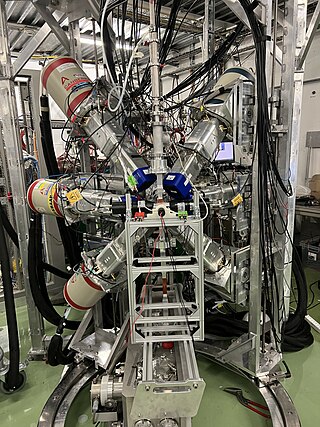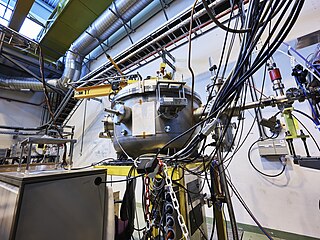In particle physics, the W and Z bosons are vector bosons that are together known as the weak bosons or more generally as the intermediate vector bosons. These elementary particles mediate the weak interaction; the respective symbols are
W+
,
W−
, and
Z0
. The
W±
bosons have either a positive or negative electric charge of 1 elementary charge and are each other's antiparticles. The
Z0
boson is electrically neutral and is its own antiparticle. The three particles each have a spin of 1. The
W±
bosons have a magnetic moment, but the
Z0
has none. All three of these particles are very short-lived, with a half-life of about 3×10−25 s. Their experimental discovery was pivotal in establishing what is now called the Standard Model of particle physics.

ATLAS is the largest general-purpose particle detector experiment at the Large Hadron Collider (LHC), a particle accelerator at CERN in Switzerland. The experiment is designed to take advantage of the unprecedented energy available at the LHC and observe phenomena that involve highly massive particles which were not observable using earlier lower-energy accelerators. ATLAS was one of the two LHC experiments involved in the discovery of the Higgs boson in July 2012. It was also designed to search for evidence of theories of particle physics beyond the Standard Model.


Gargamelle was a heavy liquid bubble chamber detector in operation at CERN between 1970 and 1979. It was designed to detect neutrinos and antineutrinos, which were produced with a beam from the Proton Synchrotron (PS) between 1970 and 1976, before the detector was moved to the Super Proton Synchrotron (SPS). In 1979 an irreparable crack was discovered in the bubble chamber, and the detector was decommissioned. It is currently part of the "Microcosm" exhibition at CERN, open to the public.

The ISOLDE Radioactive Ion Beam Facility, is an on-line isotope separator facility located at the centre of the CERN accelerator complex on the Franco-Swiss border. Created in 1964, the ISOLDE facility started delivering radioactive ion beams (RIBs) to users in 1967. Originally located at the Synchro-Cyclotron (SC) accelerator, the facility has been upgraded several times most notably in 1992 when the whole facility was moved to be connected to CERN's ProtonSynchroton Booster (PSB). ISOLDE is currently the longest-running facility in operation at CERN, with continuous developments of the facility and its experiments keeping ISOLDE at the forefront of science with RIBs. ISOLDE benefits a wide range of physics communities with applications covering nuclear, atomic, molecular and solid-state physics, but also biophysics and astrophysics, as well as high-precision experiments looking for physics beyond the Standard Model. The facility is operated by the ISOLDE Collaboration, comprising CERN and sixteen (mostly) European countries. As of 2019, close to 1000 experimentalists around the world are coming to ISOLDE to perform typically 50 different experiments per year.


KATRIN is a German acronym for an undertaking to measure the mass of the electron antineutrino with sub-eV precision by examining the spectrum of electrons emitted from the beta decay of tritium. The experiment is a recognized CERN experiment (RE14). The core of the apparatus is a 200-ton spectrometer.
The Oscillation Project with Emulsion-tRacking Apparatus (OPERA) was an instrument used in a scientific experiment for detecting tau neutrinos from muon neutrino oscillations. The experiment is a collaboration between CERN in Geneva, Switzerland, and the Laboratori Nazionali del Gran Sasso (LNGS) in Gran Sasso, Italy and uses the CERN Neutrinos to Gran Sasso (CNGS) neutrino beam.

NA61/SHINE is a particle physics experiment at the Super Proton Synchrotron (SPS) at the European Organization for Nuclear Research (CERN). The experiment studies the hadronic final states produced in interactions of various beam particles with a variety of fixed nuclear targets at the SPS energies.

The NA62 experiment is a fixed-target particle physics experiment in the North Area of the SPS accelerator at CERN. The experiment was approved in February 2007. Data taking began in 2015, and the experiment is expected to become the first in the world to probe the decays of the charged kaon with probabilities down to 10−12. The experiment's spokesperson is Cristina Lazzeroni. The collaboration involves 333 individuals from 30 institutions and 13 countries around the world.

]

FASER is one of the nine particle physics experiments in 2022 at the Large Hadron Collider at CERN. It is designed to both search for new light and weakly coupled elementary particles, and to detect and study the interactions of high-energy collider neutrinos. In 2023, FASER and SND@LHC reported the first observation of collider neutrinos.

The Scattering and Neutrino Detector (SND) at the Large Hadron Collider (LHC), CERN, is an experiment built for the detection of the collider neutrinos. The primary goal of SND is to measure the p+p --> +X process and search for the feebly interacting particles. It will be operational from 2022, during the LHC-Run 3 (2022-2024). SND will be installed in an empty tunnel- TI18 that links the LHC and Super Proton Synchrotron, 480m away from the ATLAS experiment interaction point in the fast forward region and along the beam collision axis.

The ISOLDE Decay Station (IDS) is a permanent experiment located in the ISOLDE facility at CERN. The purpose of the experiment is to measure decay properties of radioactive isotopes using spectroscopy techniques for a variety of applications, including nuclear engineering and astrophysics. The experimental setup has been operational since 2014.

The high-precision mass spectrometer ISOLTRAP experiment is a permanent experimental setup located at the ISOLDE facility at CERN. The purpose of the experiment is to make precision mass measurements using the time-of-flight (ToF) detection technique. Studying nuclides and probing nuclear structure gives insight into various areas of physics, including astrophysics.

The LUCRECIA experiment is a permanent experimental setup at the ISOLDE facility at CERN. The purpose of LUCRECIA is to analyse nuclear structure and use this to confirm theoretical models and make stellar predictions. The experiment is based on a Total Absorption gamma Spectrometer (TAS) designed to measure beta ray feeding.

The Multi Ion Reflection Apparatus for CoLlinear Spectroscopy (MIRACLS) is a permanent experiment setup being constructed at the ISOLDE facility at CERN. The purpose of the experiment is to measure properties of exotic radioisotopes, from precise measurements of their hyperfine structure. MIRACLS will use laser spectroscopy for measurements, aiming to increase the sensitivity of the technique by trapping ion bunches in an ion trap.

The Scattering Experiments Chamber (SEC) experiment is a permanent experimental setup located in the ISOLDE facility at CERN. The station facilitates diversified reaction experiments, especially for studying low-lying resonances in light atomic nuclei via transfer reactions. SEC does not detect gamma radiation, and therefore is complementary to the ISOLDE Solenoidal Spectrometer (ISS) and Miniball experiments.

The Versatile Ion polarisation Technique Online (VITO) experiment is a permanent experimental setup located in the ISOLDE facility at CERN, in the form of a beamline. The purpose of the beamline is to perform a wide range of studies using spin-polarised short-lived atomic nuclei. VITO uses circularly-polarised laser light to obtain polarised radioactive beams of different isotopes delivered by ISOLDE. These have already been used for weak-interaction studies, biological investigations, and more recently nuclear structure research. The beamline is located at the site of the former Ultra High Vacuum (UHV) beamline hosting ASPIC.

The Weak Interaction Studies with 32Ar Decay (WISArD) experiment is a permanent experimental setup located in the ISOLDE facility, at CERN. The purpose of the experiment is to investigate the weak interaction by looking for beta-delayed protons emitted from a nucleus. In the absence of online isotope production during Long Shutdown 2, the experimental setup has also been used to measure the shape of the beta energy spectrum. A goal of the experiment is to search for physics beyond the Standard Model (SM) by expanding the existing limits on currents in the weak interaction.















